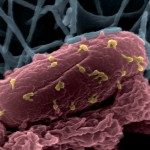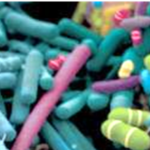Link to Pubmed [PMID] – 28130329
J Crohns Colitis 2017 Jan;
BACKGROUND AND AIMS: Adherent invasive Escherichia coli (AIEC) are abnormally predominant on the ileal mucosa of Crohn’s disease (CD) patients. They bind to the CEACAM6 receptor expressed on the surface of epithelial cells. We aimed to assess the potential of bacteriophages, viruses infecting bacteria, to decrease the levels of AIEC bacteria associated with the intestinal mucosa.
METHODS: We combined ex vivo and in vivo experiments with murine and human intestinal samples to quantify the ability of virulent bacteriophages to target the prototype AIEC strain LF82.
RESULTS: We found that three virulent bacteriophages were able to replicate in ileal, cecal and colon sections and feces homogenates from murine gut samples colonized with the prototype AIEC strain LF82. A single day of per os treatment with the three bacteriophages cocktail given to LF82-colonized CEABAC10 transgenic mice, expressing the human CEACAM6 receptor for AIEC, decreased significantly the number of AIEC in feces and in the adherent flora of intestinal sections. In addition, a single dose of the cocktail reduced over a two-week period DSS-induced colitis symptoms on conventional mice colonized with the strain LF82. The cocktail targeted also LF82 bacteria in homogenates of ileal biopsies taken from CD patients.
CONCLUSIONS: These findings demonstrate that bacteriophages are a new treatment option for targeting AIEC in CD patients and represent a strong basis for a clinical trial evaluation.



